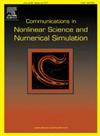Self-sustainable chaotic dynamics of a liquid crystal elastomer pendulum in radial linear temperature fields
IF 3.8
2区 数学
Q1 MATHEMATICS, APPLIED
Communications in Nonlinear Science and Numerical Simulation
Pub Date : 2025-09-16
DOI:10.1016/j.cnsns.2025.109338
引用次数: 0
Abstract
Self-sustainable chaotic systems based on liquid crystal elastomers can autonomously harvest energy from a steady external environment to sustain motion. Currently, chaotic pendulum system is usually induced by periodic stimuli and requires complex controllers, which limits its application scenarios. In this paper, a self-sustainable chaotic pendulum composed of a fiber and a mass sphere is designed under radial stimulation by introducing a steady radial linear temperature field. The corresponding nonlinear dynamic model is established to study its self-sustainable motion characteristics. The results of numerical calculation show that the liquid crystal elastomer pendulum system exhibits three distinct motion modes: periodic vibration, periodic swing and chaotic swing modes. The system compensates for the energy dissipated by damping using the net work done by the liquid crystal elastomer fiber in the linear temperature field, thus maintaining self-sustainable motion. Additionally, the paper explores the influence of system parameters on the motion behavior of the pendulum, and uses bifurcation diagrams to observe the changes in motion modes with parameter variations. It is worth emphasizing that this pendulum system can appear self-sustainable chaotic phenomenon in the position-independent driving mode. This research uncovers the thermodynamic self-sustainable motion law of the liquid crystal elastomer pendulum and proposes innovative applications in waste heat recovery, chaotic massage and chaotic heart simulation.
径向线性温度场中液晶弹性体摆的自持续混沌动力学
基于液晶弹性体的自持续混沌系统可以从稳定的外部环境中自主获取能量以维持运动。目前,混沌摆系统通常是由周期刺激引起的,需要复杂的控制器,这限制了它的应用场景。本文通过引入稳态径向线性温度场,在径向激励下设计了由纤维和质量球组成的自持续混沌摆。建立了相应的非线性动力学模型,研究了其自持续运动特性。数值计算结果表明,液晶弹性体摆系统表现出周期振动、周期摆动和混沌摆动三种不同的运动模式。该系统利用液晶弹性体纤维在线性温度场中所做的网络补偿阻尼所消耗的能量,从而保持自持续运动。此外,本文还探讨了系统参数对摆运动特性的影响,并利用分岔图观察摆运动模式随参数变化的变化。值得强调的是,该摆系统在位置无关驱动模式下会出现自持续混沌现象。本研究揭示了液晶弹性体摆的热力学自持续运动规律,并提出了在废热回收、混沌按摩、混沌心脏模拟等方面的创新应用。
本文章由计算机程序翻译,如有差异,请以英文原文为准。
求助全文
约1分钟内获得全文
求助全文
来源期刊

Communications in Nonlinear Science and Numerical Simulation
MATHEMATICS, APPLIED-MATHEMATICS, INTERDISCIPLINARY APPLICATIONS
CiteScore
6.80
自引率
7.70%
发文量
378
审稿时长
78 days
期刊介绍:
The journal publishes original research findings on experimental observation, mathematical modeling, theoretical analysis and numerical simulation, for more accurate description, better prediction or novel application, of nonlinear phenomena in science and engineering. It offers a venue for researchers to make rapid exchange of ideas and techniques in nonlinear science and complexity.
The submission of manuscripts with cross-disciplinary approaches in nonlinear science and complexity is particularly encouraged.
Topics of interest:
Nonlinear differential or delay equations, Lie group analysis and asymptotic methods, Discontinuous systems, Fractals, Fractional calculus and dynamics, Nonlinear effects in quantum mechanics, Nonlinear stochastic processes, Experimental nonlinear science, Time-series and signal analysis, Computational methods and simulations in nonlinear science and engineering, Control of dynamical systems, Synchronization, Lyapunov analysis, High-dimensional chaos and turbulence, Chaos in Hamiltonian systems, Integrable systems and solitons, Collective behavior in many-body systems, Biological physics and networks, Nonlinear mechanical systems, Complex systems and complexity.
No length limitation for contributions is set, but only concisely written manuscripts are published. Brief papers are published on the basis of Rapid Communications. Discussions of previously published papers are welcome.
 求助内容:
求助内容: 应助结果提醒方式:
应助结果提醒方式:


